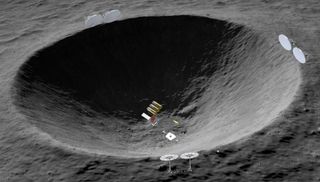
Will the US Military Space Force's Reach Extend to the Moon?

Leading military space strategy experts are pondering the role of cislunar space in the context of President Donald Trump's plan to establish a U.S. Space Force.
Just how valuable is that stretch of space between Earth and the moon's orbit? Might this celestial real estate become hot property as an extension of military arenas in low Earth orbit, medium Earth orbit, and geosynchronous orbit?
Given forecasts of 21st-century activity on and around the moon by both private and government entities, could this be an economic area of development that needs protection in sthe years and decades to come? [In Photos: President Donald Trump and NASA]
Commercially important commons
"Historically, as the commons become commercially important, it is not the military that pushes for presence there, it is the vested interests desiring protection that pull it in," said Everett Dolman, a professor of comparative military studies at the U.S. Air Force's School of Advanced Air and Space Studies at the Air University, headquartered at Maxwell Air Force Base in Alabama.
This includes protection from hostile forces, including pirates and other raiders, but also from natural threats such as extreme weather, which can affect search, rescue and recovery efforts, he said.
Just as the British and U.S. navies have made commerce on the open seas safer, and therefore more profitable, the U.S. Air Force provides a similar value for international air space and outer space, Dolman told Space.com.
Hostile spacecraft
For the space commons, Dolman said, the current military value derives from space monitoring; orbital de-confliction; space weather prediction; and threat awareness, assessment and mitigation through the globally provided space situational network.
Get the Space.com Newsletter
Breaking space news, the latest updates on rocket launches, skywatching events and more!
As commercial development accelerates, simple monitoring won't be enough, he added.
"Where we are in space today, we just monitor — hence the need for a space force," Dolman said. "A U.S. Space Force will not only conduct all of the monitoring operations it currently does fairly well, it will have to include rescue and recovery, pirate mitigation — right now mostly from hackers, but in the future from hostile spacecraft."

Rogue state/non-state actors
A space-forward military agenda in the future will include planetary defense against incoming asteroids and comets "and, most importantly, in my view, defense of the commons from rogue state and non-state actors who would find an asymmetric advantage against their terrestrial opponents by denying space-based capabilities," Dolman said.
NASA's planned moon-orbiting Lunar Orbital Platform-Gateway, which the agency hopes to build in the 2020s, and China's proposed lunar base will include at least some human occupation.
"That does not mean a human military presence will be needed in cislunar space," Dolman said. "It is simply too expensive to keep a human alive in space to make a peacekeeping or peacemaking military space force anything other than a remotely piloted vehicle or drone capability similar to the Remote Pilot Vehicle forces already available in the air." [21 Most Marvelous Moon Missions of All Time]
Law enforcement
Indeed, military space activities have always been remotely conducted, and for the foreseeable future the United States will need just a small fleet of potentially manned spacecraft that would not routinely be on orbit or stationed in space, Dolman said.
"NASA could likely maintain its cislunar human activities with a single law-enforcement agent, should it become necessary as commercial growth expands," he said.
"Military presence in space will be demanded simply from the growth of value that is generated there," Dolman said. "This value must be protected, and in areas where states do not have sovereignty, the military is the only legitimate force that can operate there. And this is a good thing for future growth. Space is our future."
Heartland
Talk of cislunar military operations depends on the time frame and one's risk aversion, said John Pike, director of Virginia-based GlobalSecurity.org.
"In the near term, within five years, and absent extreme risk aversion, a cislunar gateway has no military significance," Pike said. "It does not contribute to terrestrial force application nor to influencing those space assets that do contribute to terrestrial force application. And for some time to come, it would seem to be no more than a distraction, or a topic for people with too much time on their hands who are frustrated science-fiction writers."
However, the far term is far more difficult to assess, he said. Looking to 2050, "I could imagine that large-scale helium-3 extraction might be the key to terrestrial electrical production, and some actor might seek to monopolize lunar access to monopolize electricity. Possibly a 'lunar gateway' would be critical to control of the lunar surface, and by extension, terrestrial electrical power generation, and thus the world economy."
Pike underscored the work of Halford John Mackinder, an English geographer and a founding father of geopolitics and geostrategy. Mackinder argued that whoever controlled the heartland would dominate the world, and the history of the 20th century was largely a commentary on this theory.
"Possibly, cislunar space is the heartland of the 21st century … or maybe not. Thirty years is a long time by Moore's law standards, and this time frame is a bit too speculative," he said. (Moore's law states that the number of transistors packed into an integrated circuit doubles every two years.) [Living on the Moon: What It Would Be Like (Infographic)]

Silly analogies
For years, "space-power" theorists have written about certain orbits, Lagrange points and celestial bodies as being of "strategic" importance, said Mark Gubrud, a physicist and technology analyst. He is an adjunct professor in the Curriculum in Peace, War and Defense at the University of North Carolina, Chapel Hill.
"But territorial claims in space have no validity under international law, and are not militarily defensible, either. Any war in space would be disastrous for space operations, and since it would be a war between nuclear-armed states, it would be disastrous on Earth as well," Gubrud said.
"We need to get past thinking based on silly analogies to the military and naval strategies of the past," he added. "The choice in space is between arms control and creating an explosive confrontation that endangers all of us.".
Space cadets
"What you are asking is the long-term dream of the Air Force space cadets, one that they have kept from achieving," said Roger Handberg, a professor of political science that specializes in space policy at the University of Central Florida in Orlando. "The irony is that the Space Force, in whatever form it takes, will be the vehicle for getting to orbit, although not necessarily with humans initially."
Practically speaking, Handberg said, the military is probably focused on near-Earth space — from geosynchronous orbit inward — because that is where all critical space assets currently reside.
"What they will argue is that they should resurrect the old expeditionary model of the military leading exploration teams, à la Lewis and Clark in 1803 or so, to the moon and outward," Handberg said, "but that would be a long-term goal."
Trump has now opened the door for a robust military presence in space, but the goal of that presence remains an open question, Handberg said. Perhaps the Space Force will end up being more of a Space Guard, roughly equivalent to the terrestrial Coast Guard, as more civilians, tourists and workers enter orbit, he said.
"The military, historically, has big elbows willing to push itself forward," Handberg said.

Trade routes
For the time being, there is very little military utility to being in cislunar space, said Todd Harrison, director of the Aerospace Security Project at the Center for Strategic and International Studies in Washington, D.C.
Cislunar space is not particularly useful for current military missions like Intelligence, Surveillance and Reconnaissance; communications; Positioning, Navigation and Timing; missile warning; and so forth, Harrison said.
The military uses space, he said, to help protect the nation and U.S. national interests here on Earth.
"Until the United States has substantial security interests in cislunar space, I don't see a good reason for the military to be there," Harrison said. "If, one day in the distant future, the United States has significant economic activity transiting through cislunar space, then the military would need to look at protecting those trade routes."
He likened that scenario to the military protecting key trade routes here on Earth such as the Strait of Hormuz, which links the Persian Gulf to the Gulf of Oman and the Arabian Sea.
"But that day is still a long way off," Harrison concluded.
Leonard David is author of "Mars: Our Future on the Red Planet," published by National Geographic. The book is a companion to the National Geographic Channel series "Mars." A longtime writer for Space.com, David has been reporting on the space industry for more than five decades. Follow us @Spacedotcom, Facebook or Google+. This version of the story published on Space.com.
Join our Space Forums to keep talking space on the latest missions, night sky and more! And if you have a news tip, correction or comment, let us know at: community@space.com.

Leonard David is an award-winning space journalist who has been reporting on space activities for more than 50 years. Currently writing as Space.com's Space Insider Columnist among his other projects, Leonard has authored numerous books on space exploration, Mars missions and more, with his latest being "Moon Rush: The New Space Race" published in 2019 by National Geographic. He also wrote "Mars: Our Future on the Red Planet" released in 2016 by National Geographic. Leonard has served as a correspondent for SpaceNews, Scientific American and Aerospace America for the AIAA. He was received many awards, including the first Ordway Award for Sustained Excellence in Spaceflight History in 2015 at the AAS Wernher von Braun Memorial Symposium. You can find out Leonard's latest project at his website and on Twitter.
Most Popular


